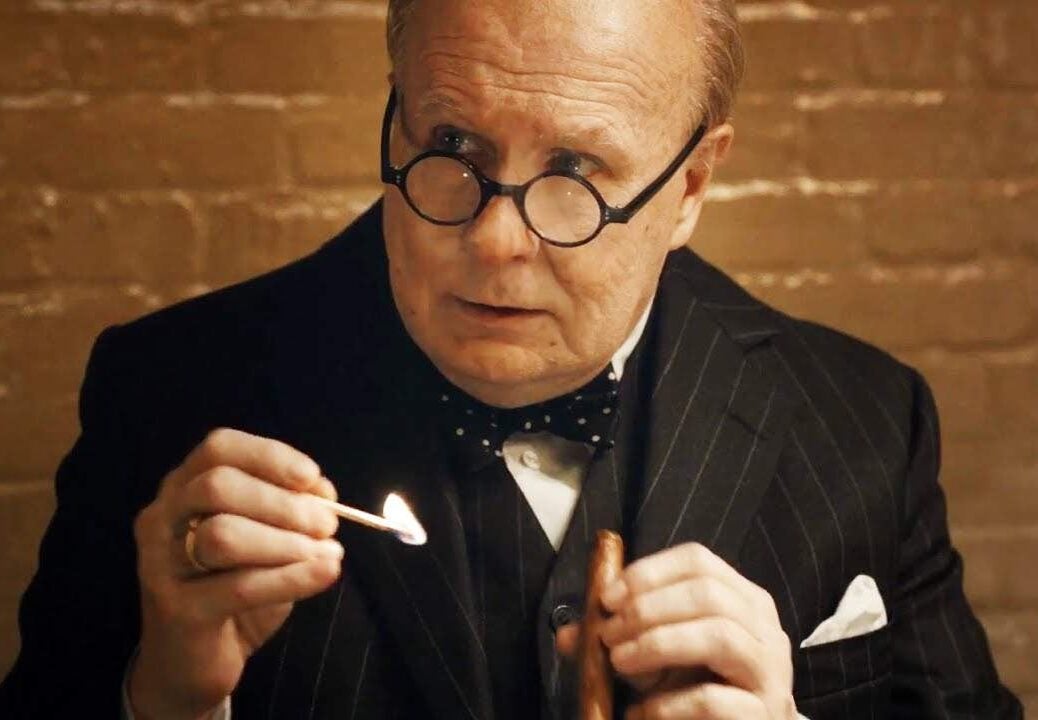
The historical accuracy might be a little stretched, but the on-screen magnetism of Gary Oldman’s Churchill makes the film worth a watch, writes Robert Clark
Gary Oldman has remarked that he wanted to bring the historical, almost mythical, Winston Churchill down from the pedestal that he has been put on, in order to look us straight in the eye in his portrayal of the man voted ‘most iconic Briton’. With only the English Channel standing between Britain and the Nazi war machine, Churchill became prime minister in 1940, nine months into the war — the only man who could garner the support of all the political parties in the newly formed coalition government. In Darkest Hour, he is tasked with choosing between continuing the policy of Appeasement followed by his predecessors or fighting to the last.
Oldman had previously worked with makeup expert Kazuhiro Tsuji and suggested to director Joe Wright (Atonement and Anna Karenina) that there was no better person to help achieve the visual transformation that would support his own impressive voice work and adoption of Churchillian mannerisms. Although there is still something unmistakably Oldman in those eyes, he does a superb job of physically and emotionally embodying both the public bravado and the private vulnerability of Churchill; the simple nervous tapping of his ring-finger on the arm of the chair contradicting the confident words and revealing the doubt beneath. This is brilliantly observed and confirmed by the worn patch on wartime premier’s chair that still sits in the Cabinet War Rooms in Whitehall. The detail forms part of a masterful portrayal.
Oldman commands the chemistry over his supporting cast in every scene. That said, Libby James’ performance as his secretary Elizabeth Layton deserves more than just a mention as this on screen relationship flourishes. Their scenes include a charming interaction where Layton points out the meaning of Churchill’s ‘V for Victory’ gesture is already known to the working classes as a sign for something completely different, resulting in Churchill’s decision to reverse the gesture. Their relationship develops to a point at which a subdued exchange following the death of Layton’s brother at Dunkirk underlines the real impacts of Churchill’s decisions. It’s a powerful moment in the film. Then there’s Kristin Scott Thomas, who as Clementine Churchill seeks to brings out the humanity in her dedicated husband. Although her screen time feels criminally short, Scott Thomas draws out the vulnerability and the empathy from Oldman’s Churchill, helping to bring the portrayal of the protagonist to the human level.
Director Joe Wright’s cinematography is a pleasure throughout; contrasting streams of light cut through darker, heavier settings. Wright keeps a fast pace, too, and allows the film to flow.
Then there’s the famous made-up scene on the London Underground, which for me, stops Darkest Hour from reaching the heights that Oldman’s arguably performance deserves. On what is possibly the longest one stop tube ride in history, Churchill seeks reassurance concerning his biggest decision yet — whether to fight on or make peace with Hitler — by asking commuters on the train. It’s a contrived addition which jars. To think a man of such conviction was reassured in such a manner is implausible to the point of absurdity.
Nonetheless Oldman’s performance breathes new life into one of the most well known and frequently portrayed figures of British history and cinema. And it is clear that script writer Anthony McCarten has given the Tinker, Tailor-star enough material to confidently throw his historic subject’s iconic Homburg into the ring for an Oscar. And one can only hope that the members of the Academy have it in their hearts to forgive the scene on the tube and not do what voters did to Churchill in 1945 and vote for someone else.
Darkest Hour stretches its historical accuracy with the inclusion of the doubtful London Underground scene. Despite this, Wright’s biopic stands out in the ring tapping hands of Oldman. The film sheds light on the hard decisions Churchill faced, the consequences of which are seen in Christopher Nolan’s Dunkirk. Darkest hour gives us a less thrilling but more human insight into how Churchill began to rearm the British people with his words.
Robert Clark is a freelance writer
Related
We must be thankful for Nolan’s Dunkirk spirit






